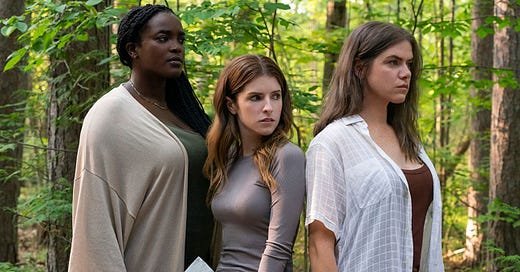Alice, Darling
Anna Kendrick gives a layered performance as a woman being psychologically abused by her boyfriend who looks to her friends for strength.
“Alice, Darling” is as accurate a depiction of an emotionally abusive relationship as we’ve seen. There have been a lot of movies made about physical abuse, which is easier to spot because victims are left bloodied and bruised.
But Anna Kendrick’s layered, quietly panicked performance as the title character shows us how Alice is completely dominated by her abusive boyfriend without his ever laying a hand on her. It’s a psychological thriller devoid of any overt violence, and yet it’s a harrowing and genuinely unnerving cinematic experience.
The story — screenplay by Alanna Francis, directed by Mary Nighy — is pretty simple. Alice is going away for a week at a lakeshore cottage with her best friends, Sophie (Wunmi Mosaku) and Tess (Kaniehtiio Horn). She has to lie to her boyfriend, Simon, a successful artist played by Charlie Carrick, telling him it’s a last-minute business trip, because he would never agree otherwise.
What’s interesting about the storytelling is that Simon actually isn’t in the movie very much. We see him a bit in the beginning and more toward the end, but mostly he exists in snippets, flashbacks and imaginings Alice experiences.
He’s more like a specter inhabiting her mind than a flesh-and-blood figure.
His controlling ways are subtle, and could be easily dismissed as helpful — encouraging healthy eating and exercise, telling her she’s too good for the job she has. But everything he does has a way of circling back to him and his own needs, as if she were to diverge in any way from his instructions it’s perceived as an attack on him.
In contrast to her small physical stature and soft, elfin features, Kendrick has projected a sense of strength and self-confidence in her characters — plucky, smart women who have to prove their worth to those who don’t appreciate them are her wheelhouse.
Here, her Alice seems to positively collapse in on herself, perpetually hunkered and flashing nervous smiles to assure she’s just fine. In a recurring motif, she wraps a string of hair around a finger, tightening until it turns purple, and then pulling some more until the hair breaks. It’s the sort of thing an observer might dismiss as a nervous habit but is really Alice internalizing the torment she experiences every day.
Sophie is the strong, centered one of the trio of friends, someone whose natural instinct is to nurture and protect. She senses that Alice is in distress but is shocked when she eventually discovers the extent of it.
She often has to act as peacemaker between Alice and Tess, who continually clash in the early days of their retreat. Ostensibly the reason for the trip is to celebrate Tess’ 30th birthday, and she’s feeling defensive and depressed because her own career as an artist hasn’t taken off. Her jealousy toward Simon is an unspoken divide between her and Alice that soon becomes a wall.
Alice needles her friends about their constant snacking and baking cinnamon rolls and other sugary treats, compared with her strict diet and early morning runs. Sugar is basically a toxin, she tells Sophie, though she might as well be speaking in Simon’s oddly accented voice.
There are clever little tertiary elements and touches that underscore Alice’s building crisis. A local teen girl named Andrea has gone missing, and the posters around town and the search parties near their retreat remind us of Alice’s own forced absence. She begins her own search, though clearly it’s not just the kid she’s hoping to rescue.
Simon’s text messages to her are accompanied by a fingersnap sound cue, which takes on an alarming note every time we hear it… an act of incursion, bordering on violence. His constant demand for her full attention is at the core of his toxicity.
Alice is clearly coming to a moment of divergence. It seems she’s headed down a path that will necessarily include separating herself from Tess and Sophie, unless she can find a way to turn her terror into self-resolve.
It’s one of Kendrick’s best performances, including several sequences where her character is experiencing panic attacks, her breath cycling in and out in frenzied waves of all-consuming anxiety. It’s tough stuff to watch, it feels so real.
“Alice, Darling” is a frightening and poignant portrait of a woman, and women all around us, who suffer unseen.





